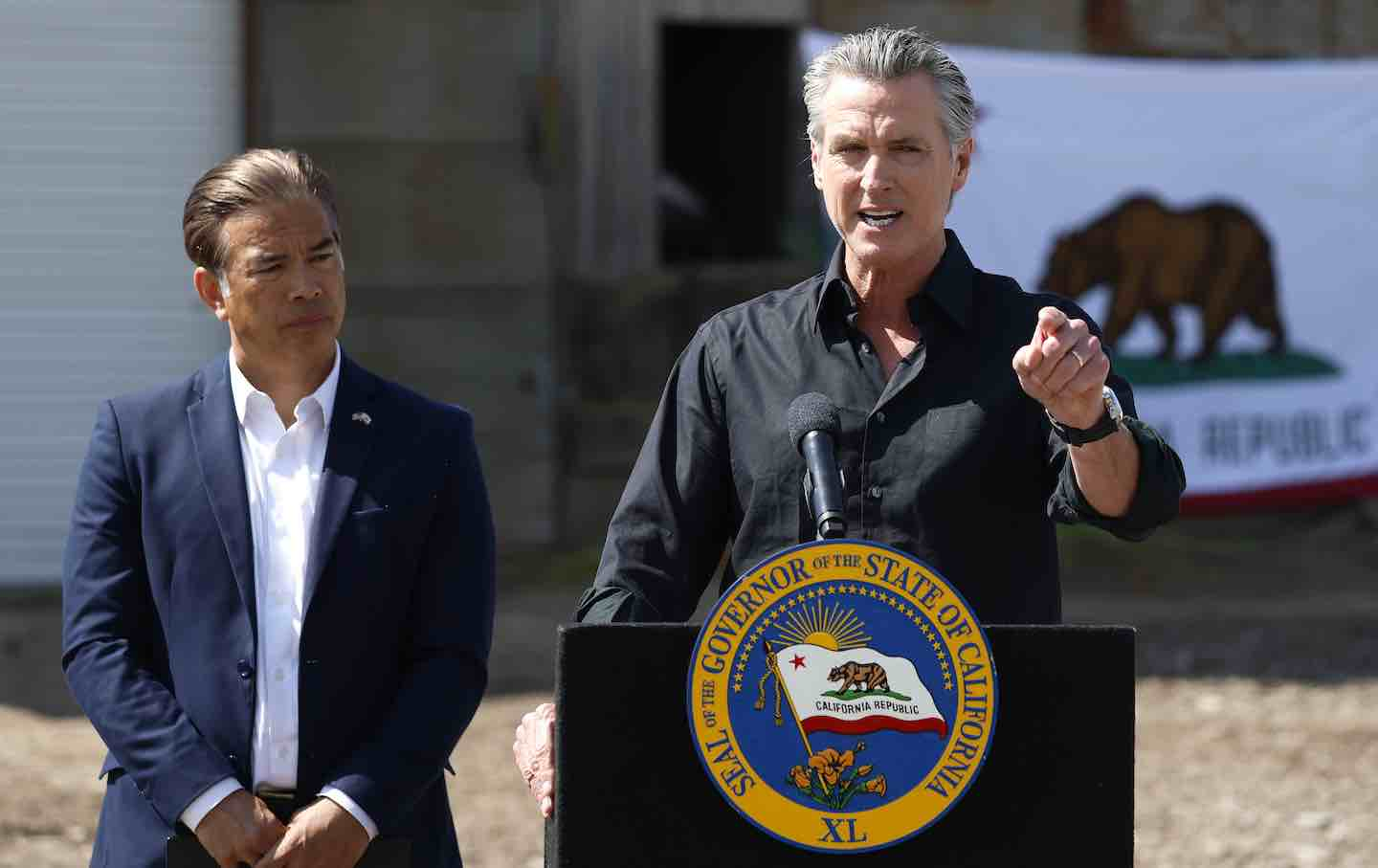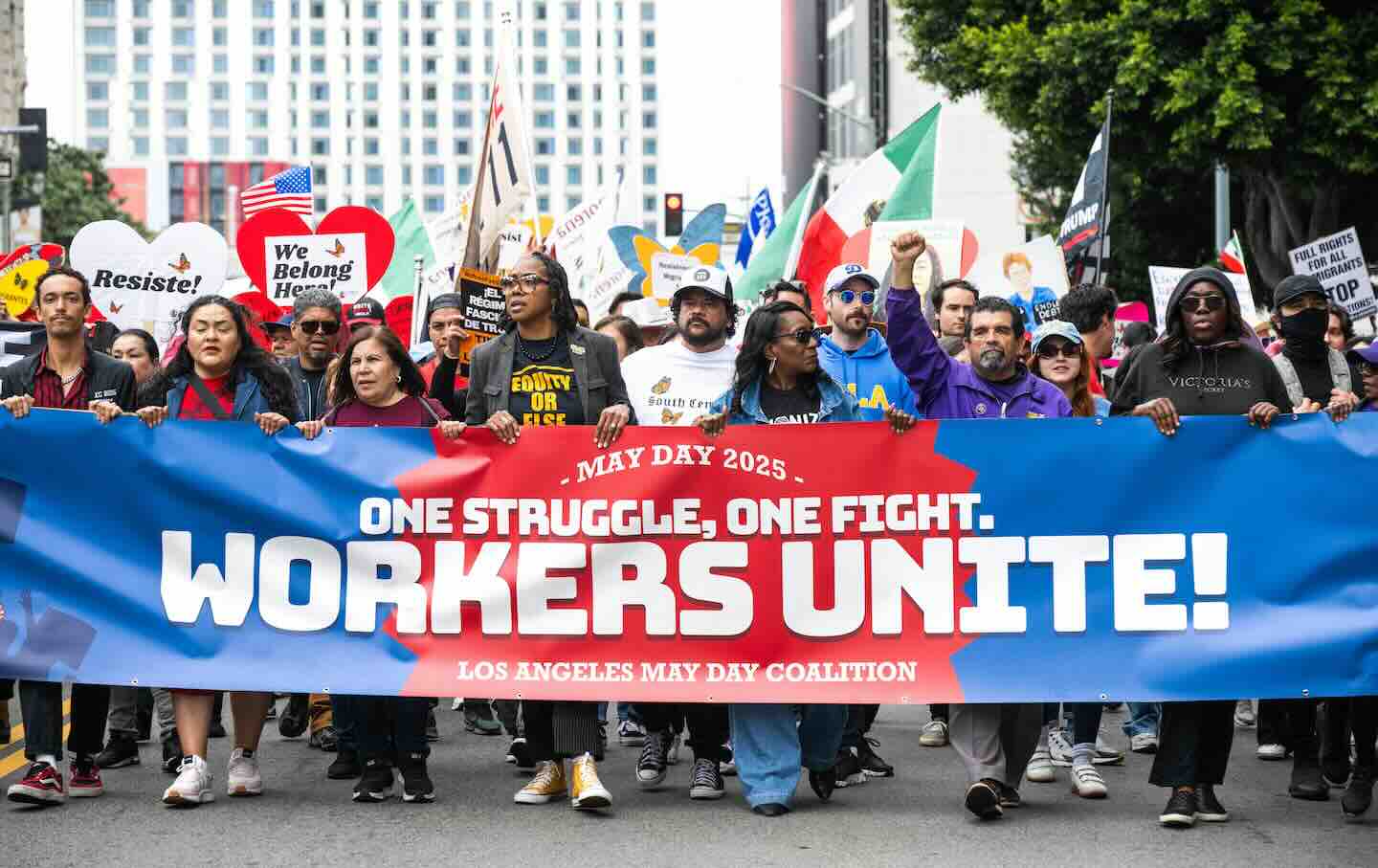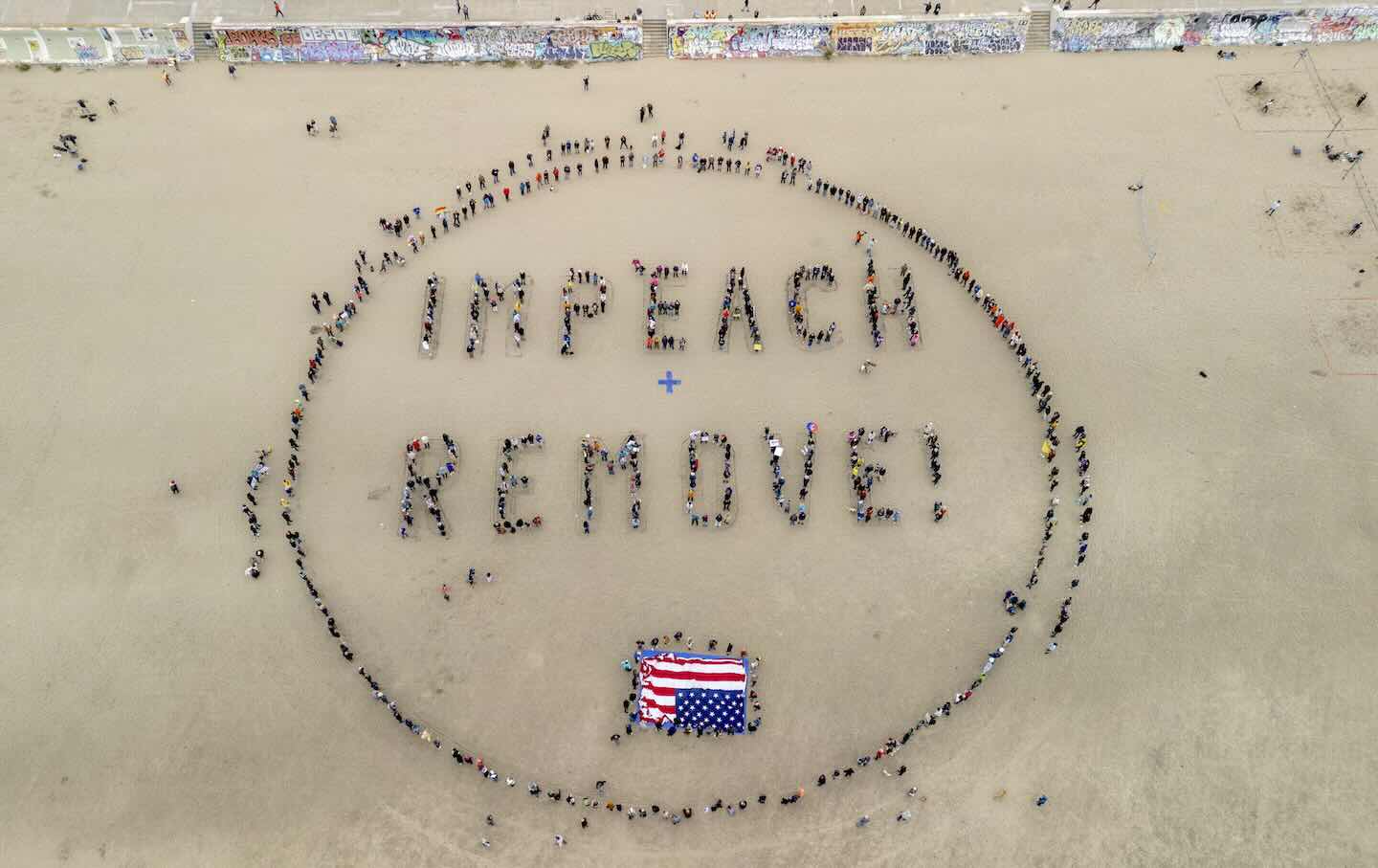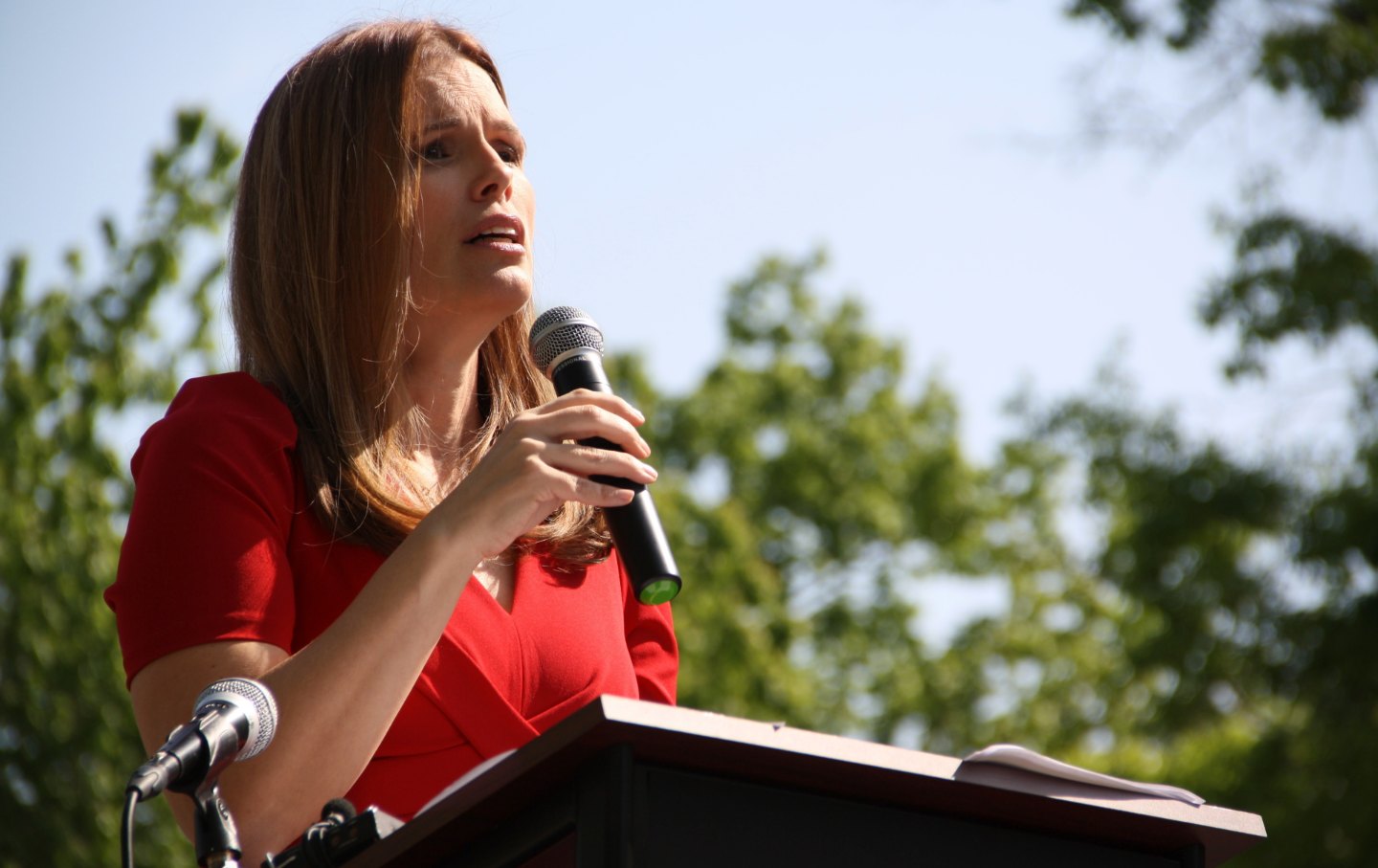Is California’s Plan to Trump-Proof the State Enough?
California officials shored up the state’s defenses to respond to Donald Trump’s lawless actions. But can their “Trump-proofing” strategy hold the line?

California Governor Gavin Newsom (R) speaks as California Attorney Gneral Rob Bonta looks on during a news conference at Gemperle Orchard on April 16, 2025, in Ceres, California.
(Photo by Justin Sullivan / Getty Images)
Sworn in as the governor of California in January 2019, Gavin Newsom seemed to delight in picking fights with his archenemy, Donald Trump, during the president’s first term. Newsom signed a bill (subsequently overturned by the courts) that would have required presidential candidates to release their tax returns to qualify for the state’s ballot; he denounced Trump in fiery language for pulling out of the Paris climate accords and for his other anti-environmental actions; and he lambasted the president’s “incompetence” and “corruption.” As a result, he became something of a poster child for anti-Trumpism, a political leader who wasn’t afraid to forcefully push back against the MAGA leader’s bullying tactics and administrative priorities.
Immediately following the 2024 election, it seemed that the pattern would repeat itself. Still governor, having survived a recall campaign and then been reelected in 2022 in a landslide, Newsom convened a special legislative session to shore up California’s defenses, warning that Trump’s election would result in new attacks on reproductive freedoms, environmental protections, and immigrant communities, as well as the weaponization of “grant programs to commandeer state and local government resources for federal purposes.” The governor called on legislators to meet and provide additional funding to the state’s justice department so that it would be better equipped to protect California’s vital interests, and to develop legislation to protect vulnerable residents from the expected federal onslaught.
Trump’s First 100 Days
Less than a month later, on December 2, legislators gathered in the ornate State Capitol in Sacramento, where they approved a $50 million infusion of cash for the state’s justice department. It was an investment in “Trump-proofing” California, the state’s political leaders said, one that would bring huge dividends should the lawsuits it would likely be filing over the coming years preserve California’s access to federal funds for disaster relief, education, and transportation, as well as its leading environmental standards and research institutions. Trump had already threatened California on all of these issues in response to California’s SB 54, the California Values Act, a 2017 law limiting cooperation with federal immigration authorities. The lawmakers also produced ideas for future legislation, especially around protecting state data on undocumented immigrants—which could be used by the feds as a road map to sweep up large numbers of undocumented residents—as well as expanding the state’s no-go zones for ICE agents.
Progressives were delighted, seeing in the Newsom of 2024 a counterweight to Trump that was similar to that of the Newsom of 2019 and 2020. But then, in early January, wildfires swept through Los Angeles, burning the Pacific Palisades and Altadena communities to the ground and complicating the state’s plans. In those swirling, wind-driven fires, everything changed.
Newsom faced a barrage of attacks from Trump, who took to calling him “Governor Newscum.” Trump and Musk added fuel to the rhetorical flames. Online, conspiracy theories circulated that LA Mayor Karen Bass and Newsom had somehow started the infernos to cover up evidence of tunnels used to transport victims of pedophilia around the city. Trump and Musk piled on to Newsom, accusing him and Bass of failing to prepare for emergencies and of being delinquent in ensuring adequate water supplies for firefighters. Instead of going on the offensive, as might have been his wont five years ago, Newsom issued some mild rebukes of those who would spread Internet rumors in the middle of a tragedy. Then he cordially invited Trump to LA to survey the fire damage, before flying to DC to persuade the president about how best to get disaster relief funds flowing to the beleaguered city. Some liberal activists were appalled. But one of Newsom’s aides said that in 2025 the governor would have to pick his fights more selectively than he had six years earlier. Indeed, in the months that followed, Newsom shied away from the role of being a foil to Trump, instead launching a podcast to try to straddle political divides, inviting alt-right influencers such as Charlie Kirk and Steve Bannon onto the show to discuss issues dear to their hearts. And in late March, he threw punches at his own party, telling Bill Maher that in many ways the Democratic brand was “toxic.” “We talk down to people,” Newsom said. “We talk past people.”
One of the governor’s aides said that Newsom, a likely 2028 Democratic presidential hopeful, believed he could manipulate Trump more effectively with a bit of well-placed flattery than if he simply went at him with rhetorical hammers and tongs. As a result, he has been happy to cede the spotlight of California “resistance” to Attorney General Rob Bonta and his legal team. “The governor is definitely choosing his words carefully,” Bonta said. “He’s met with the president; he’s appropriately sought disaster funding,” and at the same time he called the special legislative session to Trump-proof California. “So he’s working on two tracks.” In practice, what that means is that Newsom is only sparingly using his vast public platform to critique the president’s lawlessness.
Still, it is an open question whether this strategy of using the Legislature and the state DOJ to fight Trump while Newsom maintains a cordial relationship with the president will be enough to enable California to withstand the series of political tornadoes that Trump is unleashing. If anything, the overwhelming speed of the first few months of Trump’s second term has highlighted the fundamental challenges of any Trump-proofing strategy centered on litigation, which almost by definition works at a slower pace than does Trump’s burn-it-all-down brand of politics.
Everyone, including Governor Newsom’s close advisers, recognizes that the stakes couldn’t be higher. With the federal government in crisis, American society is facing a far greater stress test than it experienced during Trump’s first term. Sure, Newsom has said that highly skilled workers fired by federal agencies would be welcomed into jobs in California state government. But even a state with the vast resources of California—it recently bypassed Japan to become the fourth-largest economy on earth—doesn’t have the ability to backstop all of the federal functions that are being eviscerated by the destruction in DC, which raises the disquieting question: If California, arguably the country’s best bet for a state resistance strategy, is ultimately forced to bow to the Trumpian onslaught, what of everywhere else?
Jason Elliott, a former deputy chief of staff to Governor Newsom who’s now a strategist with Versus Solutions, has concluded that Trump 2.0 will end up being a battle to the political death between the forces of MAGA and the forces of liberalism in America, especially those epitomized by California. “In order for the MAGA theory of the universe to hold water, California must fail,” Elliott says. But if California succeeds, “this diverse, progressive place where people can exist peaceably living side by side, then the core tenet of the MAGA theory fails. We’re a state that doesn’t demonize other people.”

Following through on its mandate to use litigation to block the administration’s unlawful actions at every turn, Bonta’s team is a party to at least 12 ongoing lawsuits against Trump 2.0, as of early April. The team has been working with 22 other Democratic state attorneys general in crafting lawsuits to counter many of Trump’s policies. They have challenged Trump’s executive order attacking birthright citizenship, the Office of Management and Budget memo seeking to pause the distribution of $3 trillion in federal funds, DOGE’s access to the Treasury Department’s payment system, and research funding cuts to NIH. Bonta’s team has also joined other state AGs in suits against cuts to the Department of Education, efforts to claw back Covid funds from schools, and attempts to neutralize congressionally funded agencies such as the Minority Business Development Agency and the Institute of Museum and Library Services. And in late April, they announced a lawsuit challenging Trump’s tariffs, which have already hurt the state’s economy and will likely do far more damage over the coming months. The lawsuit argues that in imposing them without congressional input, Trump was overstepping the bounds of his authority.
So far, Bonta noted, with a few exceptions the administration has largely abided by the temporary restraining orders issued in several of these cases, though he worried that might change. “There is a lot of foreshadowing—indications that are very disturbing,” Bonta said, whether it was JD Vance’s tweets about the illegitimacy of court rulings or Trump’s open defiance in the case of Kilmar Abrego Garcia, the Maryland father who was wrongly deported. The US Supreme Court ordered that the administration must facilitate Garcia’s return to the states, but there has been no indication that Trump is complying with that order; indeed, Trump recently acknowledged that he had the power to bring Garcia home but was not going to do so. “The courts have to do their job. And we would go to court, for example, if there was a clear order that was violated by the Trump administration, and we believed it was intentional, and we could prove that intent,” Bonta said. “We would seek contempt-of-court orders from the judges.”
Given the uncertainty surrounding the courts and their ability to hold administration officials to account, it’s tempting to see the Trumpian assault on due process and American democracy as unstoppable, particularly in the wake of the workforce purges and cuts in funding for critical programs. But Bonta was not buying it. “There’s been a narrative created that I don’t subscribe to around Trump being more sophisticated and better at imposing his agenda,” the state attorney general argued. “And I haven’t seen it yet. There’s been a higher volume of actions—many more executive orders, memos—so there’s much more to react to. But much of what he’s done has, in my perspective, been sloppy, ham-handed, and easy to identify the illegality of it.”
Constitutional scholars in California seem to agree that in the early days of the administration, the divisions of power between the federal government and the states were still holding. One expert, who, like many in academia at the moment, was reluctant to speak on the record for fear of drawing the administration’s wrath, explained that while the balance of power between the executive and legislative branches was at risk at the federal level, “The federal-state balance seems fine or normal right now.” So long as that remains the case, he argued, California is in a good position to weather the storm.
Elliott, Newsom’s former deputy chief of staff, is confident that if the courts remain the final arbiter, California will navigate this crisis successfully and will manage to protect its people and most of its signature policies. But he, along with a growing number of Democratic leaders and legal scholars, also worries that the guardrails against extralegal behavior are quickly breaking down. In the immigration realm in particular, the Trump administration seems to feel emboldened to ignore the courts. If these guardrails do fail, then it’s by no means clear that a litigation-based strategy will be enough to put the brakes on the MAGA-fication of America. In such a scenario, it will be particularly important for major blue-state governors such as Newsom to forcefully spell out to the American public exactly what is at stake. And, while Illinois Governor J.B. Pritzker has leaned into this role with gusto, so far Newsom has chosen to go the low-key route.
Even without going entirely outside of the law, Trump 2.0 can do a whole heap of damage simply by implementing huge cuts to federal programs upon which all states, to one degree or another, rely. In fact, in many ways it is the existential threat to state budgets posed by the GOP’s efforts in Congress to gut the social safety net, rather than Trump’s extra-constitutional actions, that represents the single biggest risk to California. The fate of Trump’s “big, beautiful bill”—which is expected to fund the president’s policy agenda while cutting funding for Medicaid, housing assistance, childcare, health research, and other social spending—will be decided later this summer. But California officials are not waiting for a draft of the legislation to plan their response.
As early as March, state agencies and officials, as well as the powerful California Federation of Labor Unions, were looking for ways to marshal California’s resources to fill the voids that would be left by the federal government’s abrupt withdrawal of funds and of partnerships in everything from healthcare to education, from diversity initiatives to the running of science labs.
At a webinar organized by the American Federation of Teachers in early February, State Superintendent of Public Instruction Tony Thurmond was asked what California could do if the federal Department of Education is destroyed. “California has to be ready to backfill any services that may be lost,” Thurmond said. “You all should feel good that our students are covered for now. Our best defense is a good offense. And we’ll work hard to prevent the DOE from closing.” Beyond the platitudes, Thurmond promised to push hard for state legislators to raise taxes on wealthy Californians, who will benefit mightily from the tax cuts that Congress looks poised to pass, so as to generate funds to protect education services in the state. Similar conversations are underway about how to raise revenues to save California’s healthcare system.
Lorena Gonzalez, California Labor Federation’s president, has been thinking about the role that unions, as well as California’s web of union-friendly labor laws, will play in the state in the coming years, as the Federal Department of Labor, OSHA, the National Labor Relations Board, and other regulatory institutions in DC that monitor labor and civil rights conditions play a diminished role under Trump. “There’s a lot of education going on, a lot of reliance on collective bargaining,” she says. The Federation has been participating in protests against the privatization of basic public services, such as the US Postal Service, as well as large demonstrations in the Central Valley community of Delano against ICE raids on undocumented farm workers. It has distributed information criticizing the Trump administration’s defunding of California’s high-speed rail project. And it has played a lead role in a “Kill the Cuts” campaign to protest the slashing of science grants to universities and public health systems.
Gonzalez argues that California has a strong enough package of pro-labor laws on the books that it can create a powerful counternarrative to Trump’s. The state has, for example, banned employers from requiring workers to attend anti-union meetings. It has a law allowing state legislative staff to unionize—in stark contrasts to Trump’s efforts to end collective bargaining rights for federal employees. It has the highest minimum wage in the country, and a law mandating sector-wide collective bargaining in the fast-food industry. And it has a unionization rate about one and a half times that of the US workforce as a whole.
All of this gives unions in California outsize clout. As the Republicans advance their efforts to gut Medicaid, Gonzalez believes that California and the Labor Federation will be able to wage a popular “Hands Off Medi-Cal campaign” to protect the expansive California version of Medicaid, which provides healthcare not only for those eligible under federal guidelines but a large proportion of the state’s undocumented population as well. When the GOP comes for labor protections, she believes that California will be able to provide living proof that protecting workers is a good social investment.
In the meantime, California Senate majority leader Lena Gonzalez’s office has heard reports of areas that day laborers frequent being raided and of dozens of migrants simply being dumped over the border into Mexicali. Gonzalez’s team has also heard from schools in the Central Valley that many students have stopped attending classes because their families are so concerned about immigration raids on school grounds—which is why the senator has made it a priority to pass legislation preventing school officials from cooperating with ICE.
For Angelica Salas, the executive director of the Coalition for Humane Immigrant Rights in Los Angeles (CHIRLA)—probably the most influential immigrants’ rights organization in the state—the cat-and-mouse game with ICE has taken on new urgency, particularly as the president invokes antiquated policies like the Alien Enemies Act of 1798 to deport those he has deemed criminals, whether or not they actually have committed any crimes, and demands that all immigrants over the age of 14 register with the government. CHIRLA has coordinated dozens of groups, including trade unions and churches, in the Los Angeles region to develop rapid response teams in the face of raids. More than 220 volunteers joined these teams between November and March. “We’re organizing our community to build a really strong foundation of both defense and in the future our positive vision of immigration,” Salas said.

Throughout Southern California, CHIRLA organizers are teaching immigrants their legal rights. They are working with eligible residents to help them complete green card and citizenship applications. And, most immediately, they are making it clear that whenever ICE raids neighborhoods, it will be observed, and filmed, by rapid response activists.
In the month following Trump’s inauguration, Pedro Trujillo, the head of CHIRLA’s rapid response network, estimates that volunteers were called out to verify roughly 60 reported ICE sightings in Los Angeles County. Many, it turned out, were false alarms, everything from utility vehicles to FEMA trucks with DHS decals. “If there were to be mass raids, the rapid response network would activate to offer support to community members,” Trujillo says. “Let them know their rights, make sure ICE aren’t being abusive. And if people are detained, we would offer them legal counsel.”
While Newsom has taken a backseat in the anti-Trump resistance this go-round, everyday Californians have continued to step up and fill the void. Throughout the late winter and spring, there have been large protests in one or another locale on a near-daily basis. Noisy demonstrations have popped up outside Tesla dealerships around the state. Students have engaged in high school walkouts to protest Trump’s immigration policies. And activists of all ages have shut down freeways near LAX to protest the crackdown on the undocumented and on asylum seekers.
Californians’ grassroots pushback does not just involve protests, however. Largely below the radar, self-help and mutual aid movements are picking up steam, some of them explicitly taking their cues from the work of the Black Panthers in Oakland and other cities more than a half-century ago. They are attempting to close at least some of the gap left by the sudden removal of billions of dollars of federal aid to states and cities, by ramping up their distribution of food, health care, and education resources in communities particularly hard hit by the federal cuts. And, as they do so, they are holding political education sessions explaining what is going on and why this moment is significant.
Popular
“swipe left below to view more authors”Swipe →“How do we build institutions that are independent; that are not reliant on the system in any way?” asks Ahjamu Umi, sitting in a café in the Oak Park neighborhood of Sacramento. Umi was raised by Black Panthers and has worked with a pan-Africanist movement, the All African People’s Revolutionary Party, for more than four decades. “If [the federal government] is all dismantled in three weeks, then you didn’t really have it in the first place; it’s not stable.” Umi’s group has been on the ground in Oak Park for decades. “I’ve been doing this almost 41 years, my entire adult life,” he says, “And I’ve never seen it having more potential than it does right now. More and more people are being disaffected by what they see, and realizing they have to take responsibility for the society they want.”
Five miles to the west, in the adjacent city of West Sacramento, an urban farm has, in recent years, sprung up on riverfront land, protected by a raised levee, which is leased from the state by the International Rescue Committee—which got, until Trump put the axe to the refugee resettlement program, federal dollars to help refugees begin their new lives in the United States. On some of those sandy-soiled acres, refugees from Afghanistan and elsewhere grow crops such as the gandana—an Afghan leek—strawberries, onions, okra, and loofah (a type of gourd). The remainder of the land is subleased out to groups such as Seeds of Solidarity Farm, which works with undocumented immigrants, excluded from the social safety net, who want to grow their own food.
“It [allows] people to start to think proactively instead of reactively when it comes to social organizing,” says Natalia, who works as a volunteer with the farm.
The volunteers eat what food they need, and they distribute the rest of the harvest in parks, at NorCal Resist offices, and in food pantries dotted around Sacramento. Each week they hold educational sessions on farming and politics. Natalia says that the number of volunteers working at the farm has risen and then risen again in the months since Trump was elected, though she doesn’t have exact numbers. “We’re anticipating that will continue, Natalia said. “People really want to do something.”
This web of resistance in California gives the state at least a fighting chance against some of the mayhem to come. But will it be enough without Newsom making the decision to use his public platform to aggressively push back against Trump’s cruel authoritarianism?
For Lorena Gonzalez, California is primed to wage this fight. “I don’t think that Trump will be able to do everything he fantasizes he’s going to do,” the labor federation president says. Even with Newsom’s relative silence in recent months, the people of California are not backing down. “I refuse to have my energy sapped by the speed with which they’re releasing their ideas, many of which are going to be very unpopular,” said Gonzalez. “They want us to become demoralized. And the more we refuse to be, the harder their agenda will be.”
More from The Nation

Trump Looks to Libya in Its Latest Deportation Scheme Trump Looks to Libya in Its Latest Deportation Scheme
A judge has halted the plan, but only a fool would believe the threat is now over.

Why the “Abundance Agenda” Could Sink the Democratic Party Why the “Abundance Agenda” Could Sink the Democratic Party
Big-money donors are using the “abundance agenda” to create a permission structure for Democratic elites to dismiss the populist revival the party so desperately needs.

Immigrants Are Part of the Fabric of Our Country Immigrants Are Part of the Fabric of Our Country
The life-and-death struggles migrants face.

How Philadelphia Is Fighting Back Against Donald Trump’s Anti-Worker Crusade How Philadelphia Is Fighting Back Against Donald Trump’s Anti-Worker Crusade
The Protect Our Workers Enforce Rights Act can serve as a model for cities all across the country.

A GOP Scheme to Steal a North Carolina Supreme Court Seat Has Been Foiled A GOP Scheme to Steal a North Carolina Supreme Court Seat Has Been Foiled
A Trump-appointed federal judge rejected a bizarre GOP attempt to disenfranchise voters after they cast their ballots.

Trump Has Made His First Round of Judicial Picks—and They’re Terrifying Trump Has Made His First Round of Judicial Picks—and They’re Terrifying
The appointments—which include an attorney who helped steer a major anti-trans case—are about the failures of the Democrats as much as the ruthlessness of Republicans.


